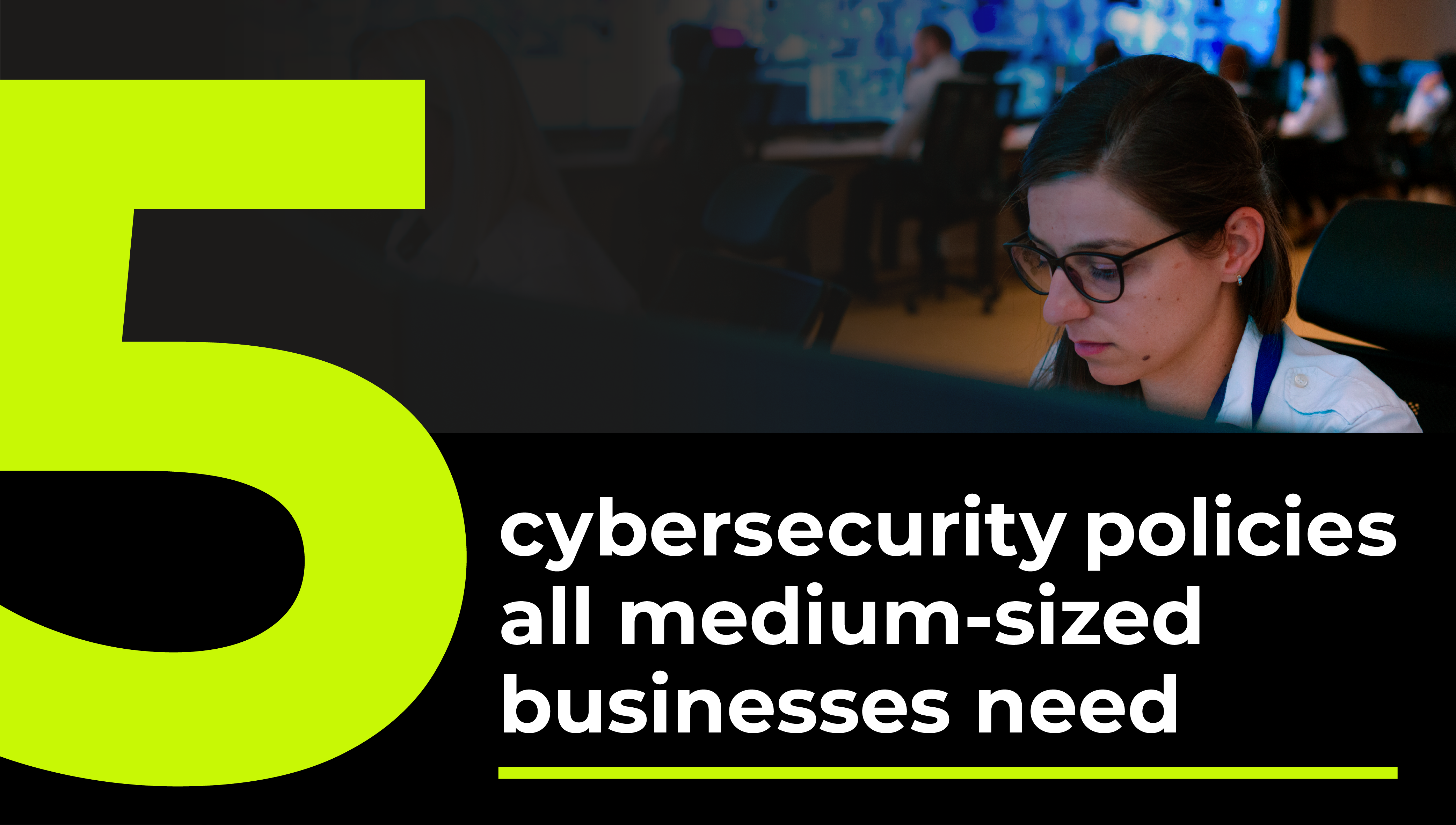
5 Cybersecurity policies every medium-sized business needs
By Scott Putman
Your employees can’t protect themselves against cyber attacks if they aren’t aware of the dangers they expose themselves and your business to daily. Ongoing training and clear rules are necessary to keep up with how fast things change in this field and provide accurate technology advice for your company. Cybersecurity policies can provide the needed guidance and ensure everyone knows how to behave during “business as usual” and in the case of a cyber incident.
Why are cybersecurity policies so critical? A Canadian organization's average data breach cost was $6.75 million in 2021, and ransomware-related costs continue to increase yearly. Your organization is still at risk even with a rock-solid cyber insurance policy.
Even with the best cybersecurity and infrastructure security in place, cyber attacks can impact your bottom line years after an incident occurs due to the costs involved, including lawsuits, high insurance premiums, ongoing investigations, and negative press.
Cybersecurity policies spell out cybersecurity guidelines for employees, board members, and third-party collaborators, establishing rules and norms that protect against online business systems and data risks.
What are security policies?
A cybersecurity policy is a document including rules and best practices for specific actions within a company. It provides a realistic road map for daily activities so that end users can better protect themselves and the company data from cyber attacks.
Cybersecurity policies and procedures have multiple roles within the organization:
- They increase cybersecurity awareness so everyone in your team can recognize and correct dangerous behaviour.
- They support employees and collaborators in their daily activities and guide senior management to make better decisions around operations, tools, and employee interactions.
- They provide clear instructions for what to do (and not do) when an incident occurs.
- They create the environment for efficient internal communications to guarantee that each team observes cybersecurity rules.
- They assist organizations in adhering to compliance standards and improving their cybersecurity strategy with recommendations and best practices based on the company's industry and the data they retain.
What security policies should a medium-sized business have?
A medium-sized business's most important security policies must cover the key areas that ensure day-to-day operations run smoothly. The purpose is to provide straightforward advice, keep end-users updated on the latest cybersecurity trends, and clarify roles and responsibilities if an incident occurs.
As a general guide, medium-sized businesses need the following cybersecurity policies:
1. Information Security Program
The Information Security Program is the backbone of your strategy to safeguard essential business operations and IT assets. This document lists all the people, systems, and tools involved in managing your assets' confidentiality, integrity, and availability (CIA).
Some of the most important elements to cover in this document are:
- Access management
- Data classification and protection
- Data breach management
- Data backups and disaster recovery
- Employee training and user awareness
- Password requirements
- Third-party risk management
This policy is essential for implementing the proper administrative, technical, and physical measures through an information security program. The document must be updated as you develop and implement new and more effective security procedures over time.
2. Incident Response Plan
An organization can benefit from an Incident Response Plan in many ways, including protecting digital assets, drastically lowering the expenses associated with cybercrime, and ensuring a positive brand reputation with partners and clients.
The Incident Response Plan must contain detailed instructions and best practices for securing backups, maintaining the adequate identity and access control, and promptly correcting vulnerabilities.
Some of the must-have elements to include in this document are:
- The scope and planning scenarios
- Protocols for notification, escalation, and declaration
- The logical flow of events for incident response
- Team roles and responsibilities
- Instructions for testing
The plan must include precise, doable actions that the team can do immediately in the event of an emergency. The strategy must be thorough but still provide room for flexibility to accommodate a variety of circumstances. Evaluate and update the plan every six to 12 months to ensure the necessary flexibility without compromising the quality of the instructions.
3. Security and Privacy Awareness and Training Policy
Your staff is your first defence against cybercrime, so all employees must be aware of any security dangers that can develop during regular business operations. However, in real-life situations, things aren’t straightforward regarding security awareness.
Employees disregarding security standards are responsible for breaches in over 74% of organizations. Therefore, protecting the confidentiality, integrity, and availability (CIA) of sensitive information requires ongoing training, and the Security and Privacy Awareness and Training Policy provides the framework for it.
This document must mention the frequency of training, the people responsible for scheduling and implementing it, how the courses will be provided, and the information they must include to be effective.
4. Patch and Maintenance Plan
Patching is an essential part of preventive maintenance for IT systems, so a strategy to streamline and operationalize patching while enhancing risk mitigation is required to maintain cybersecurity standards.
The Patch and Maintenance Plan will establish clear expectations for patch and vulnerability management, being also an effective tool for holding teams accountable. It can also include a service-level agreement between groups to guarantee the completion of all tasks around decreasing risk.
The document must include information about:
- The technical teams in charge of patch management and maintenance
- The framework for collaboration between these teams
- Terminology to ensure all parties speak the same language
- A backup strategy in case your patch management procedure falters and causes problems
- The tools and resources used to evaluate risk and complete tasks
Your Patch and Maintenance Plan should comply with existing laws and regulations mandatory for your industry, such as HIPAA and GDPR.
5. Bring Your Own Device (BYOD) Acceptable Use And Security Policy
You require a BYOD Security Policy if your business permits employees to use their personal laptops, tablets, or cellphones while working. This practice increases the chance of an employee posing a security risk to your organization.
Here are some of the crucial components of a BYOD policy:
- The resources and applications accessible to employees from personal devices
- Device security measures, including a list of applications that are prohibited on personal devices
- A list of the components supplied by the business
- The company’s rights around remote data wiping for lost or stolen devices
- The available IT support for personal devices and the applications installed on them
- The ownership of apps and data and reimbursement details
The BYOD Security Policy requires a multifaceted strategy that considers as many dangers as possible while not limiting employee privacy or usability. It’s vital to ideate and implement context-aware security solutions to reach the balance and keep risks low.
The characteristics of effective cybersecurity policies
While it may seem obvious, the most important characteristic of any cybersecurity policy is that it must be effective. Too many policies are rigid and unrealistic, hindering rather than helping performance.
A workable cybersecurity policy is strong enough to prevent unauthorized system access while being permissive enough to allow your staff and business partners to do their jobs. To reach that balance, policies should be:
- Realistic. All the instructions and best practices listed must match existing resources and consider end-users skills and knowledge.
- Attainable. The policies must meet the organization’s needs and align with existing processes, so they don’t limit anyone’s ability to perform their daily tasks successfully.
- Updated. With cyber threats continuously evolving, it’s vital that organizations revisit these documents regularly or every time new business requirements are implemented.
- Compliant. Policies must reflect industry standards and, where applicable, cyber insurance requirements.
- Endorsed. Executive buy-in is crucial to foster a security culture throughout your organization, so make sure leadership follows the same rules for increased efficiency.
Conclusion
Cybersecurity regulations and internal policies as a company's best cyber defences, but they can quickly become a barrier to day-to-day operations. Errors in the policy's wording, application or enforcement can undermine the security system's effectiveness despite your significant efforts.
There is no simple or fast way to create and implement a bullet-proof cybersecurity policy. In this context, working with qualified cybersecurity experts is the most effective way to support your employees while protecting your organization.
If you aren’t sure where to begin with cybersecurity policies or simply need to update your existing document, our templates can be a great starting point that can be customized to include specific information that better meets your organization’s needs.




